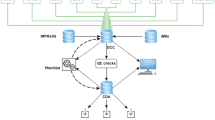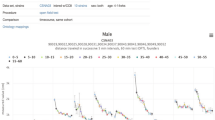Abstract
A concerted effort to develop myriad new phenotypic alleles through mutagenesis programs presents new challenges for the biomedical community and for the informatics infrastructure needed to support this work. To handle and co-ordinate large programs of treatment, breeding, and sequential or longitudinal testing for a variety of obvious and subtle traits requires sophisticated data management software. Further, trait analyses, heritability testing, and animal availability and status must be captured and disseminated to the wider community. The Mouse Genome Database (MGD) will serve as the central integration point for the various mutagenesis programs, registering new alleles, providing accession identifiers, and capturing phenotypic descriptions. In addition, MGD will provide public access to unified searches over all alleles with links to the centres of origin for detailed testing data.
Similar content being viewed by others
References
Ashburner, M., C. A. Ball, J. A. Blake, D. Botstein, H. Butler, J. M. Cherry, A. P. Davis, K. Dolinski, S. S. Dwight, J. T. Eppig, M. A. Harris, C. P. Hill, L. Issel-Tarver, A. Kasars-kis, S. Lewis, J. C. Matese, J. E. Richardson, M. Ringwald, G. M. Rubin & G. Sherlock, 2000. Gene Ontology: tool for the uni cation of biology. Nat. Genet. 25: 25–29.
Blake, J. A. & M. Harris, 2003. The Gene Ontology Project: Structured vocabularies for molecular biology and their application to genome and expression analysis, in Current Protocols in Bioinformatics, edited by A. D. Baxevanis, D. B. Davison, R. Page, G. Stormo & L. Stein, Wiley & Sons, Inc., New York.
Bult, C. J., J. A. Blake, J. E. Richardson, J. A. Kadin, J. T. Eppig & the Mouse Genome Database Group, 2004. The Mouse Genome Database (MGD): integrating biology with the genome. Nucl. Acids Res. 32: D476–D481.
Davidson, D., J. Bard, M. Kaufman & R. A. Baldock, 2001. The Mouse Atlas Database: a community resource for mouse development, Trends Genet. 17: 49–51.
Eppig, J. T., 2000. Algorithms for mutant sorting: the need for phenotype vocabularies. Mamm. Genome 11: 584–589.
Eppig, J. T. & M. Strivens, 1999. Finding a mouse: The International Mouse Strain Resource (IMSR). Trends Genet. 15: 81–82.
Pargent, W., S. Heffner, K. F. Schable, D. Soewarto, H. Fuchs & M. Hrabe de Angelis, 2000. MouseNet database: digital management of a large-scale mutagenesis project. Mamm. Genome 11: 590–593.
Ringwald, M., J. T. Eppig & J. E. Richardson, 2000. GXD: integrated access to gene expression data for the laboratory mouse. Trends Genet. 16: 188–190.
Strivens, M. A., R. L. Selley, S. J. Greenaway, M. Hewitt, X. Liu, K. Battershill, S. L. McCormack, K. A. Pickford, L. Vizor, P. M. Nolan, A. J. Hunter, J. Peters & S. D. Brown, 2000. Informatics for mutagenesis: the design of mutabase-a distributed data recording system for animal husbandry, mutagenesis, and phenotypic analysis. Mamm. Genome 11: 577–583.
Author information
Authors and Affiliations
Rights and permissions
About this article
Cite this article
Strivens, M., Eppig, J.T. Visualizing the Laboratory Mouse: Capturing Phenotype Information. Genetica 122, 89–97 (2004). https://doi.org/10.1007/s10709-004-1435-7
Issue Date:
DOI: https://doi.org/10.1007/s10709-004-1435-7




